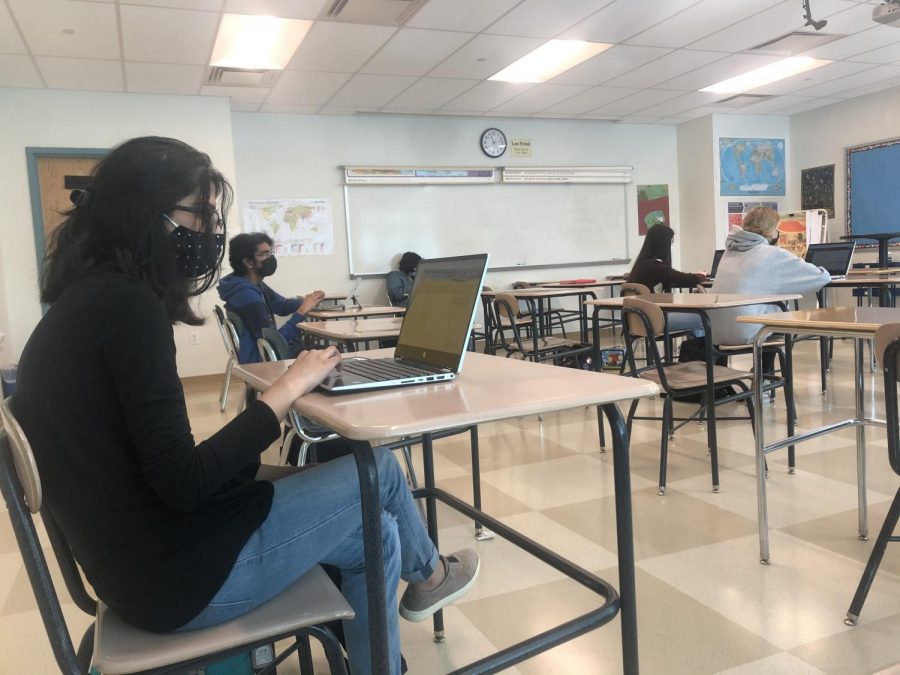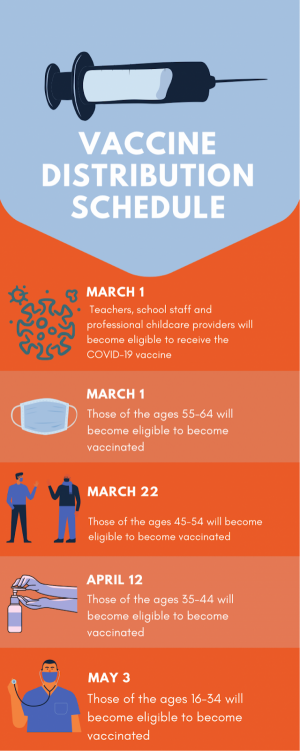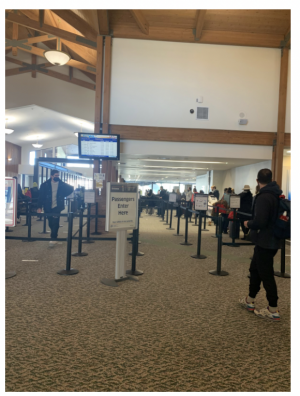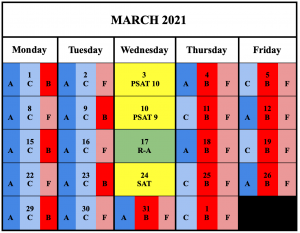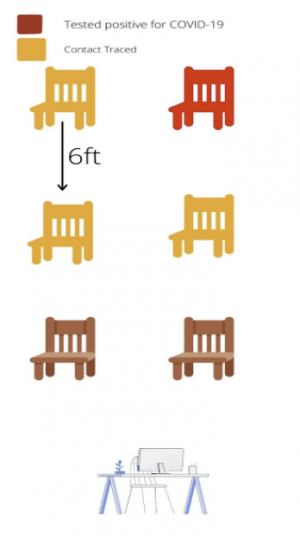Staples moves to 75% capacity hybrid model; elementary, middle schools open fully in-person
Photo by Finnegan Courtney '23
Staples will transition to a 75% in-person hybrid model beginning on March 1, despite teachers yet receiving vaccinations. While teachers, staff and child care personnel are set to be vaccinated throughout March as per Governor Ned Lamont’s updated vaccine distribution plan, the uncertainty of the time table incites concerns among staff and students.
A 75% capacity hybrid model, in which students are divided among four cohorts with three in person at a time, will be implemented at Staples starting March 1. Under this model, hybrid learners will attend school in-person three days a week with Wednesdays remaining as remote days.
Westport’s elementary and middle schools began transitioning to full in-person learning on Jan. 28. All hybrid students at the middle schools attend school four days a week, with a remote half day on Wednesdays. Distance learning remains an option at both the elementary and middle school level.
“Balancing our public health responsibility with the needs that our students have,” Superintendent Thomas Scarice said in a Board of Education meeting on Jan. 19, “I think the benefits of a full on-site in-person schooling is so important […] that it is a time to move in that direction.”
Reactions
In light of new more contagious strains of COVID-19, teachers and staff only becoming eligible for vaccines on March 1, and the cold weather which worsens the effects of the virus, many Staples students view the expanded hybrid model with uncertainty.
“I think that there is certainly a risk that comes with there being more people is the building,” Sebastian Anderson ’24 said. “It is also especially dangerous because there are new strains of COVID, and it will far harder to contact trace with more people at school.”
Despite the added health risks that come with a greater capacity of students in the building, some students at the elementary and middle schools believe that their school administrations’ mitigation and contact tracing protocols have allowed for the transition to take place successfully.
“At first, [I thought] it wasn’t well thought out due to the rising COVID numbers to start,” Matthew Stashower ’25 said, “but they are doing a good job since they have put a lot of protocols in to place such as plastic dividers of desks, strict mask wearing and assigning people to certain places so they can contact trace.”
Many parents of elementary school children feel that the return to full in-person learning was necessary from a social and emotional health aspect, as social interactions are desperately needed for children that age.
“My little kid feels very lonely at home and seems more fulfilled when he is at least partially in school and feels much better when at school full-time,” Coleytown elementary school parent Victoria Liahk said. “Distance learning for elementary school students seems to destroy their personality.”
Jennifer Greely, a paraprofessional at Saugatuck Elementary School and a mom to three children in Westport Public Schools, noted that the increase in daily core academic time between the elementary full-time in-person model and the hybrid model is about 30 to 45 minutes, while 65 minutes have been added to account for time needed to transition between various daily activities.
“I see that the ability of a single teacher to sit and connect with each child is greatly diminished,” Greenly said, “in part from the lack of space now that 20-plus old fashioned desks are spaced a few feet apart from one another, covering nearly every inch of available floor space in some classrooms.”
Vaccination
Scarice informed the district of Connecticut Governor Lamont’s decision to add teachers to the 1B vaccine rollout group in an email to Westport families on Feb. 22. The district plans to hold vaccine clinics for teachers and staff. The first clinic is scheduled for March 3, but it will take the majority of the month to vaccinate all employees.
The fact that teachers are unvaccinated has caused widespread opposition to Staples’ increase to 75% capacity and the move to fully in-person for grades kindergarten through eighth. Westport Education Association, the union which represents the districts’ teachers, is among those who object.
“Our [WEA] position is that we should not be doing full in until all staff have had a chance to get vaccinated and a couple of weeks afterwards to reach full potency,” WEA representative John Horrigan said.
Many district teachers have also expressed apprehension regarding greater in-person numbers without staff vaccines.
“If we were vaccinated, if we were put to the front of the line, I think we’d feel a lot more comfortable,” Italian teacher Enia Noonan said. “Unfortunately, when you have the idea that we’re being told we can’t get vaccinated yet and yet you’re having 75% come in, it’s a very conflicting and unsettling message.”
Westport parent Robert Harrington started a petition to “Protect Our Teachers” that was sent to Superintendent Scarice, the Board of Education, Westport town leaders and the town’s state senators and representatives. With over 1100 signatures from community members, the petition was originally focused on giving teachers and school employees access to full vaccinations before the district returns to full on-site instruction; however, its purpose remains relevant as most teachers and staff have not yet received access to vaccines.
“I wished our school administration had shown more patience until our teachers could be safely vaccinated,” Harrington said, “especially given the arrival of new strains and the impossibility of maintaining [six feet] distance given the increase of students in the buildings.”
Voices Heard and Unheard
The choice to bring more students in-person before teachers are vaccinated has brought questions to light regarding what groups impact district decisions.
“I’ve been here a very long time,” Noonan said, “and I’ve always felt that we were together as a community. These kinds of things make us feel—I just wonder to myself, are we all on the same page?”
Westport Parent Robert Harrington feels that teacher voices have not been fully considered when the decision for a greater in-person return was made, and he believes that the administration should rethink their current ways of communication with teachers.
“So many teachers have reached out and are nervous and upset,” Harrington said. “We should have done a better job of listening to many of them. Our teachers are the ones in the [classrooms] and face to face with our kids and have many creative ideas to protect them better.”
Jennifer Greely, a paraprofessional at Saugatuck Elementary School and a mom to three children in Westport Public Schools, emphasizes the lack of representation of teacher concerns that were sent to the Board of Education and the Superintendent’s office, but had not been addressed for a long time.
“Until the public comment section of the January [19,] 2021 Board meeting, not once did I hear from any of these public leaders that teachers or staff had serious concerns about the WPS ability to open safely,” Greely said.
Timing
Staples’ move to 75% capacity begins March 1, one week after the end of February break. Greely stated that many families traveled out of state, and some out of country, during the break. She expressed that the district has no consequences in place for families who do not abide by state travel restrictions, making her uneasy about returning. Staples student Lucy Belknap ’21 felt similarly.
“Personally I think it would make more sense to just keep the school at half capacity until it’s safe enough to bring everyone back,” Belknap said. “Especially right after break when so many people have been traveling, it feels a bit rushed and unnecessarily dangerous.”
In attempts to limit a travel-induced spike in cases after the break, members of the Westport community requested the implementation of a post-break Parent Contract; this would require families to confirm that they had not traveled outside of the tri-state area before their children returned to school. Harrington states that the measure was turned down by Superintendent Scarice, stating it was unenforceable.
Absent, Present Online
Alongside the move to a 75% in-person model, Staples has released a reformed Absent, Present Online (APO) policy for students. Hybrid learning students will only be permitted to utilize the APO attendance option due to illness or required quarantine and their parents must contact school personnel in those circumstances.
If a student is APO without a parent excuse, the absence is unexcused and may affect a students’ ability to earn credit at Staples. Students with four or more APOs in a marking period will be required to meet with a school administrator in order to discuss consequences and a potential move to the full-time distance learning option.
“Although I do understand why some students would like the option of being APO some days while not having to fully commit to going fully online, I do feel that the option has been abused in some cases and has had an impact on the Staples atmosphere,” Ella Thompson ’22 said. “[… My] take on the situation is viewing the positives of this new policy, as it may help restore the collaborative and interactive environment that Staples had pre-COVID.”
At the beginning of the school year, the APO option was put in place to limit potential COVID spread, giving students the option to stay home, but still attend class online, on a day-to-day basis if they were feeling sick. As the year progressed, the district claimed widespread abuses of the APO system with students choosing to stay home even when they were not feeling unwell, necessitating a reform to the policy.
“They were changing it because it wasn’t being used for the purpose that it was created,” Anna Fitzpatrick, a school nurse and APO committee member, said. “People were using it because they may have felt like staying home or they wanted to travel, so it makes it very hard for teachers to plan their lesson when they don’t know who’s going to be present and who’s not.”
Other Precautions & Protection
The district purchased a supply of KN-95 masks for staff members in order to provide protection against virus transmission.
Greenly indicates that staff members have only been allotted one mask each, which they are instructed to re-use for up to 80 hours. Emails from Staples nurse Sandra Resnick tell staff members to store their mask in a paper bag in order to keep it clean between uses.
The process for obtaining a second mask to allow for a daily rotation of two masks requires the employee to make a special request to the health office and explain why the second mask is needed. Greely was only granted a second mask upon her third request, after being told to purchase her own supply.
“If there is a sufficient KN95 mask supply for educators and staff in our district, why are there such hurdles for employees to receive just two masks to rotate as suggested?” Greely said. “Generous Westport parents purchased extra masks so that teachers and staff might be able to follow safety protocols by rotating their use, but puzzlingly, the central office has announced that such donations are not necessary.”
Greely further stresses that the over 400 KN95 masks that have been ordered are not sufficient for a workforce of over a thousand employees. In the middle schools, full reopening occurred prior to the arrival of both the KN95 masks and the plexiglass desk shields that have been stationed at every other desk.
In addition to the lack of resources, many precautions that had been effective in the hybrid model are no longer able to be enforced with greater class sizes. In an email from Staples Principal Stafford W. Thomas Jr. to Staples staff on Feb. 21, he states that the distance between desks in classrooms is now between three feet and five feet, nose to nose.
“As our elected officials here in town ask Westport residents to take extra precautions by limiting indoor gatherings, maintaining social distancing measures, and adhering to strict mask-wearing,” Greely said, “our school officials are simultaneously removing every single one of these mitigating measures from our schools, which have up to this point worked so successfully to limit in-school transmission.”














































